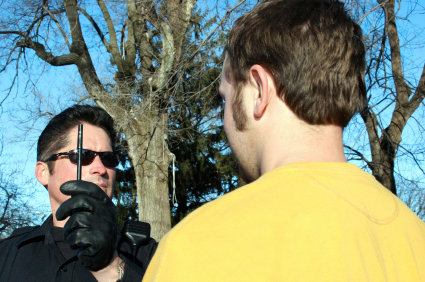
The walk-and-turn test (WAT) is a field sobriety test that was approved by the National Highway Traffic Safety Administration for use in detecting intoxicated motorists. The WAT has been standardized and is used by all police and sheriff’s departments in DUI arrests.
Field sobriety testing usually takes place roadside during the traffic stop. However, the police may transport the driver to another location temporarily in order to complete testing.
The driver may or may not technically be under arrest while performing sobriety testing. Generally, the driver is under arrest only if he or she is handcuffed and placed in the rear of a squad car or transported to the police station. If the driver has been arrested, it does not affect sobriety testing. The officer does not have to read the driver his or her rights (i.e., Miranda warnings) prior to beginning the tests. Most police departments have a booking room for DUI arrests that is set up for sobriety testing, and a video camera usually records the procedures.
The WAT has basically two parts. First, the test requires the driver to balance standing heel-to-toe while listening to instructions from the police officer on how to perform the test. The difficulty in this task is that the driver is required to split his attention between balancing in an awkward position and listening to detailed instructions.
The second part of the WAT is the walk-and-turn itself. The test involves the driver taking nine steps forward on a line (real or imaginary), turning, and taking nine steps back to the original position.
The police officer should give the driver the following instructions, and demonstrate:
Place your left foot on the line and then your right foot in front of it, like this.
The police officer’s heel on his right foot should be touching the toes on his left.
When I tell you to begin, take nine heel-to-toe steps down the line, turn around, and take nine heel-to-toe steps back.
Make your turn by keeping one foot on the line and using the other to turn, like this.
The police officer should walk down the line in a heel-to-toe fashion. The test does not require the officer to take all nine steps for demonstration. In fact, he should take less. From the heel-to-toe position, with the right foot in front of the left, the first step is made by placing the left foot in front of the right. The officer should make the turn by pivoting on the left foot, taking a 3-4 small steps around with the right foot, and then return in the same manner. Once this is completed, the officer should resume the heel-to-toe position.
Keep your hands at your sides, watch your feet at all times, and count your steps out loud. Do you understand?
The police officer is supposed to wait for the driver to acknowledge that he understands.
Begin and count your first step from the heel-to-toe position as “one.”
If the driver requests for the instructions to be repeated, generally the officer will repeat only part of them. The officer should remind the driver to watch is feet if he does not do so.
The police officer will observe the driver performing the tests and grade him. The officer is looking for nine clues that would indicate the person is impaired by alcohol or drugs:
- Cannot keep balance while listening to the instructions.
- Starts before the instructions are finished.
- Stops while walking to steady self.
- Does not touch heel-to-toe.
- Steps off the line.
- Uses arms to balance.
- Loses balance while turning.
- Incorrect number of steps.
- Cannot do the test.
If the police officer observes any of the above, then the driver is assigned one point for each factor. If the driver commits any of the above infractions, such as using arms to balance, on more than one occasion, the officer is supposed to assign only one point for that factor. For example, if the person uses his arms five times, the officer only assigns one point total for using his arms to balance.
If the driver stops the test or has difficulty at one point in the test, the officer should direct him to resume from that point, not start over.
At all times, the police officer should watch the person from about three or four feet distance, and should remain motionless. Being too close or excessive movement will distract the driver and affect his ability to perform the test.
If the driver gets two points (such as using arms for balance and stepping off the line), then he has failed the test. At trial, the police officer would testify that, based on his training and experience, and the suspect’s performance on the walk-and-turn test, he was able to form an opinion that the defendant was under the influence of alcohol or drugs. This may result in a verdict of guilty on the charge of DUI.

